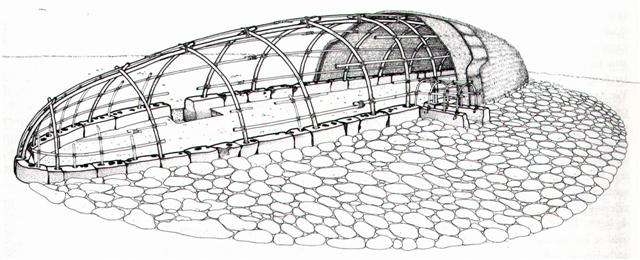Next page in the
dictionary:
|
3.
However,
neither
of
these
two
explanations
may
be
the
primary
one.
Instead
we
should
observe
two
bent
henua
(GD37),
meeting
at
two
points,
like
the
hinges
of a
clam.

Together
this
ought
to
mean
a
year,
the
two
bent
henua
being
the
half-years
'winter'
and
'summer'.
The
hinges
would
then
be
the
solstices
(though
perhaps
in
ancient
times
the
equinoxes
- a
more
resonable
interpretation
because
of
the
sharp
bends
=
quick
changes
of
the
sun).
There
is a
Nauru
myth
describing
the
limits
of
our
(temporal)
world
like
the
shell
of a
clam
(see
honu).
The
interpretation
of
GD25
(pure)
as
hare,
the
(vacant)
house
of a
creature,
is
reasonable.
Because:
"...
to
enter
a
war
canoe
from
either
the
stern
or
the
prow
was
equivalent
to a
'change
of
state'
or
'death'.
Instead,
the
warrior
had
to
cross
the
threshold
of
the
side-strakes
as a
ritual
entry
into
the
body
of
his
ancestor
as
represented
by
the
canoe."
(Starzecka)
The
hare
paega
on
Easter
Island
therefore
(I
think)
had
their
entrances
in
the
middle
of
one
of
the
long
sides
of
the
'canoe'.
And
the
foundation
stones
of a
hare
paega
are
similar
to
the
henua
in
GD25.

(Van
Tilburg)
The
hare
pure
as
'the
abode
of
the
gods'
is a
possible
reading
of
GD25;
hare
can
be
translated
as
'structure'
and
in
the
structure
of
hare
pure
the
'openings'
are
at
the
'stem'
and
the
'prow'.
A
canoe
is
also
a
structure
and
hare
paega
is
like
an
overturned
canoe
(with
openings
for
the
gods
at
the
stem
and
prow).
The
war
canoe
has
a
figure-head
(rei)
at
the
bow
(mua)
and
another
at
the
stem
(muri):
| Rei. Mother of pearl; rei kauaha, fin. Mgv.: rei, whale's tooth. Mq.: éi, id. This is probably associable with the general Polynesian rei, which means the tooth of the cachalot, an object held in such esteem that in Viti one tooth (tambua) was the ransom of a man's life, the ransom of a soul on the spirit path that led through the perils of Na Kauvandra to the last abode in Mbulotu.
The word is undoubtedly descriptive, generic as to some character which Polynesian perception sees shared by whale ivory and nacre. Rei kauaha is not this rei; in the Maori whakarei designates the carved work at bow and stern of the canoe and Tahiti has the same use but without particularizing the carving: assuming a sense descriptive of something which projects in a relatively thin and flat form from the main body, and this describes these canoe ornaments, it will be seen that it might be applied to the fins of fishes, which in these waters are frequently ornamental in hue and shape. The latter sense is confined to the Tongafiti migration. Reirei, to trample down, to knead, to pound. Churchill. |
Butterflies
are
also
thin
and
move
with
the
softest
of
sounds.
Fatness
and
noise
characterize
life
at
its
prime. |
If spring is
like a
caterpillar,
then we expect a
time of pupa to
follow, and then
the butterfly
will fly away.
We consult
English
Etymology:
pupa ...
chrysalis ...
modL. use by
Linnæus
(1758) of L.
pūpa, doll;
cfr PUPPET.
puppet
... †doll;
(human) figure
jointed and
moving on
strings or wires
... lathe-head
...
chrysalis
... form taken
by an insect in
the stage
between larva
and imago ... L.
chrysal(l)is
... Gr.
khrūsallis
gold-coloured
sheath of
butterflies, f.
khrūsós
gold ...
imago
... (entom.)
final stage of
an insect ...
Mod. use (by
Linnæus,
1767) of L.
imāgō IMAGE.
image
... artificial
representation
of an object,
likeness,
statue;
(optical)
counterpart ...
mental
representation
... rel. to
IMITATE ...
Beyond the
'pupa' stage in
the course of
the golden sun,
i.e. during p.m.
and after
midsummer, the
real sun is no
longer present -
only his image.
From new year
(midwinter) he
has been
present, and now
he has left us
(presumably now
in Hiva).
The silvery moon
has also such a
development, but
more like a moth
than a
butterfly.
The statues of
Easter Island
are images of
the real persons
now gone to
Hiva.
I
suddenly realize
why it is
forbidden in
some cultures to
make images of
the god(s).
I feel it
necessary to
include, at pure
in the glyph
dictionary, the
essence of these
thoughts. It
must be a
hyperlink from
'Butterflies', I
think.

